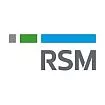- in Canada
Key takeaways
| Businesses are exploring how outsourcing can help them navigate global supply network complexity. | Digital solutions can improve planning, inventory management and trading partner collaboration. | A supplier risk assessment can help provide greater insight into your supply chain. |
The reemergence of supply chain uncertainty as a key business concern is an impetus for middle market companies to explore how technologies and outsourced solutions can boost their supply chain resilience.
Indeed, recent survey data from the RSM US Supply Chain Special Report shows that the appetite is there. When the survey—conducted by Big Village Insights and fielded March 5-14, 2025—asked 309 supply chain decision makers at middle market companies in the U.S. and Canada a series of statements evaluating their current supply chain processes, nearly all (93%) expressed confidence in the accuracy of data for decision making, while nearly as many simultaneously agreed they need to invest in technology to become more effective at managing operations (91%). There was also a strong interest in new technologies, with nearly 9 in 10 (88%) agreeing they would like to explore how AI can best be deployed to achieve success.
In his work as an RSM US management consulting principal, Jake Winquist sees clients making strategic investments in supply chain talent or upgrading their technology. Those approaches might be especially important for middle market companies that aren't resourced at the same level as their larger counterparts.
"You read about some of the big players moving manufacturing from Asia to the United States, but for a lot of the middle market that is such a big lift," he says. Instead, midsize firms are seeking ways to optimize their tech stacks and investing in advanced planning systems and software to improve inventory strategy and overall supply chain visibility.
"That's where we see many companies trying to continually get smarter," Winquist says. The RSM supply chain survey results bear that out: 51% of respondents identified inventory management as a top item of importance to their organization's supply chain over the next 12 to 24 months.
Still, achieving that optimal level of advanced planning and visibility "takes so much cross-functional collaboration to get there," Winquist says.
Working with a third-party advisor can be a valuable step in accelerating that progress. RSM's supply chain report found that middle market businesses are exploring how outsourcing can help them navigate the complexities associated with the evolving interconnectedness of global supply networks.
Many survey respondents said their organization is currently using a third-party supply chain consulting service, and most said they would consider doing so if they weren't already. Here's a breakdown of services they reported currently working with a third party for:
- Sales and operations planning (S&OP) (57% of respondents)
- Monitoring supplier risk (53%)
- Outsourced supply chain planning (45%)
- Outsourced procurement (43%)
Planning is clearly a priority. But as it stands, most companies are not integrated with supply chain partners in a way that enables collaborative planning, says RSM US management consulting principal Casey Chapman.
"It's hard to get your trading partners all on a common platform to exchange information and data," he says. "It takes time and money to do that, and often they might prioritize a couple of their biggest customers who might essentially force them to align to a certain way of doing things." Still, he adds, deploying digital solutions can help with planning and inventory management, and embracing those solutions enables collaborative planning with the trading partners that are ready to engage.
Harnessing technology, an external advisor can conduct a supplier risk assessment that taps into that broader universe of supply network data to provide:
- Greater insight into your supply chain
- Analysis of your supply chain risk, including financial,cybersecurity, geopolitical and operational risks
- Identification of mitigation strategies that align with best practices and standards
- Evaluation of environmental, social and governance risks and the identification of opportunities that may enhance your company's ESG position
A digital maturity foundation
With the evolving tariff environment and related uncertainty, reducing risk in the supply chain should be a top priority of middle market companies. Having reliable data and the correct systems architecture in place is foundational in that effort.
Most companies surveyed already have systems in place to harness data throughout their supply chains, according to RSM's report findings. Respondents reported a surprisingly high level of digital maturity in their supply chains, on a scale of 1 to 5:
- 0% rated their digital maturity at Level 1. (Data is gathered ad hoc and manually.)
- 3% rated their digital maturity at Level 2. (Data is available but inconsistently entered and maintained.)
- 28% rated their digital maturity at Level 3. (The company has a big data solution and gathers data from critical inputs.)
- 47% rated their digital maturity at Level 4. (Data is gathered from every function and automatically analyzed by BI or another data stack.)
- 21% rated their digital maturity at Level 5. (Enterprise data is unified to a single source of truth.)
Especially for those on Level 2 or Level 3 of their journey, there are many opportunities to improve connectivity. That's where digital transformation services can help; external advisors can use digital platforms to identify value drivers, uncover profit and cash flow opportunities, reduce risk, and assess the broader system architecture.
The content of this article is intended to provide a general guide to the subject matter. Specialist advice should be sought about your specific circumstances.


